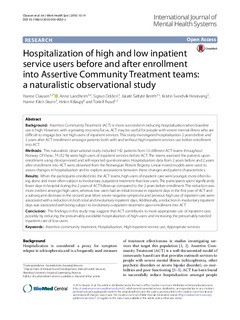| dc.contributor.author | Clausen, H. | |
| dc.contributor.author | Landheim, A. | |
| dc.contributor.author | Odden, S. | |
| dc.contributor.author | Benth, J.Š. | |
| dc.contributor.author | Heiervang, K.S. | |
| dc.contributor.author | Stuen, H.K. | |
| dc.contributor.author | Ruud, T. | |
| dc.date.accessioned | 2018-05-18T12:04:40Z | |
| dc.date.available | 2018-05-18T12:04:40Z | |
| dc.date.issued | 2016 | |
| dc.identifier.citation | Clausen, H., Landheim, A., Odden, S., Benth, J. Š., Heiervang, K. S., Stuen, H. K., . . . Ruud, T. (2016). Hospitalization of high and low inpatient service users before and after enrollment into Assertive Community Treatment teams: A naturalistic observational study. International Journal of Mental Health Systems, 10(14). | nb_NO |
| dc.identifier.uri | http://hdl.handle.net/11250/2498576 | |
| dc.description.abstract | Background
Assertive Community Treatment (ACT) is more successful in reducing hospitalization when baseline use is high. However, with a growing recovery-focus, ACT may be useful for people with severe mental illness who are difficult to engage but not high users of inpatient services. This study investigated hospitalization 2 years before and 2 years after ACT enrollment amongst patients both with and without high inpatient services use before enrollment into ACT.
Methods
This naturalistic observational study included 142 patients from 12 different ACT teams throughout Norway. Of these, 74 (52 %) were high users of inpatient services before ACT. The teams assessed the patients upon enrollment using clinician-rated and self-reported questionnaires. Hospitalization data from 2 years before and 2 years after enrollment into ACT were obtained from the Norwegian Patient Registry. Linear mixed models were used to assess changes in hospitalization and to explore associations between these changes and patient characteristics.
Results
When the participants enrolled into the ACT teams, high users of inpatient care were younger, more often living alone and more often subject to involuntary outpatient treatment than low users. The participants spent significantly fewer days in hospital during the 2 years of ACT follow-up compared to the 2 years before enrollment. The reduction was more evident amongst high users, whereas low users had an initial increase in inpatient days in the first year of ACT and a subsequent decrease in the second year. More severe negative symptoms and previous high use of inpatient care were associated with a reduction in both total and involuntary inpatient days. Additionally, a reduction in involuntary inpatient days was associated with being subject to involuntary outpatient treatment upon enrollment into ACT.
Conclusion
The findings in this study may suggest that ACT contributes to more appropriate use of inpatient care, possibly by reducing the presumably avoidable hospitalization of high users and increasing the presumably needed inpatient care of low users. | nb_NO |
| dc.publisher | International Journal of Mental Health Systems | nb_NO |
| dc.rights | Navngivelse 4.0 Internasjonal | * |
| dc.rights.uri | http://creativecommons.org/licenses/by/4.0/deed.no | * |
| dc.subject | assertive community treatment | nb_NO |
| dc.subject | hospitalization | nb_NO |
| dc.subject | high inpatient service use | nb_NO |
| dc.subject | appropriate services | nb_NO |
| dc.subject | pasientforløp | nb_NO |
| dc.title | Hospitalization of high and low inpatient service users before and after enrollment into Assertive Community Treatment teams: A naturalistic observational study | nb_NO |
| dc.type | Journal article | nb_NO |
| dc.source.volume | 10 | nb_NO |
| dc.source.journal | International Journal of Mental Health Systems | nb_NO |
| dc.source.issue | 14 | nb_NO |
| dc.identifier.doi | 10.1186/s13033-016-0052-z | |

